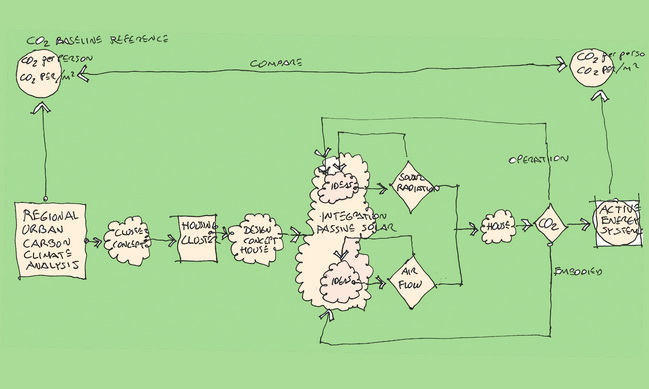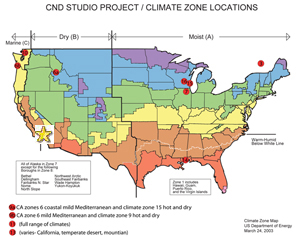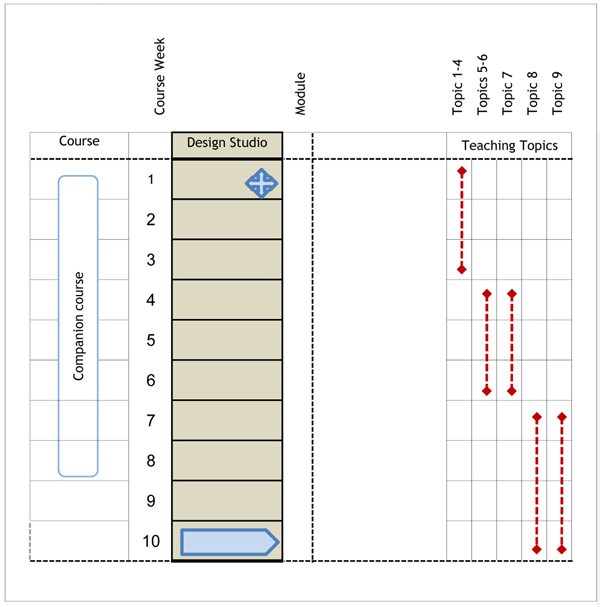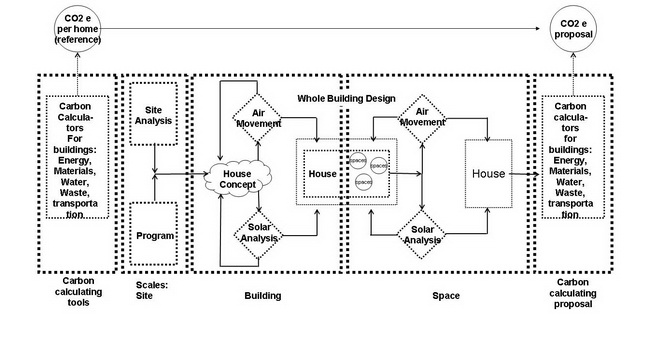Fall 2007, 2008 graduate/undergraduate elective ‘Topics Studio’
Pedagogical Overview, Philosophy and Strategies

Design Performance Objective |
Carbon Neutral Design Process
Flow chart
|
Student: name |

The climate of instruction is HOT ARID. The principles of the projects could be applied to any climate zone, and many are specifically designed to address multiple climate types. |
|
Fall 2007, 2008 graduate/undergraduate elective ‘Topics Studio’
Pablo La Roche Ph.D. LEED®-AP
Associate Professor of Architecture
Cal Poly Pomona
pmlaroche@csupomona.edu
There is no doubt now that humans are modifying climate (IPCC, 2007) and that buildings are responsible for a major portion of green house gas emissions that cause climate change. Furthermore, the U.S. population is projected to grow significantly over the coming decades, increasing the need for new buildings, including housing for this growing population. As architects we must learn how to reconcile the urgent need for new housing with the necessity to reduce our impact on climate change. We must innovate in many areas while reducing carbon impact. However, architects have not been trained to reduce the carbon impact of buildings and do not know how to quantify their carbon emissions. Thus, to reduce building related anthropogenic warming, architecture students must learn how to design buildings with a reduced environmental impact and carbon emissions. This studio addresses the need to improve carbon neutral design education while teaching them how to improve the quality of contemporary housing in an era of increased environmental concerns.
Fourth and fifth year students with Masters of Architecture I students participated in these studios and developed carbon neutral homes in two southern California climate zones: the inland desert and the temperate coast. In the first studio, emphasis was on developing strategies to reduce emissions due to operational energy and construction. In the Fall 08 studio, students included the analysis of emissions from water and waste. Transportation, which is related to building location, was also considered. Numbers are very imprecise but helps to create an initial picture of how building related carbon is being emitted. A flow chart diagram for a carbon neutral design process was developed to serve as a roadmap for a studio that took ten weeks to complete. During this period students had to analyze climate and geographical data, generate ideas, and evaluate them with different tools, such as carbon calculators, and tools such as Climate Consultant, Ecotect, HEED, Radiance, WinAir, and PV watts. Emphasis was on the generation and evaluation of environmental ideas, especially those that affected carbon emissions. Students continuously evaluated the carbon performance of their projects and had to demonstrate that their finalized idea performed as intended.
The first step in this CND process was to analyze census, climate, CO2 and population data to compare CO2 emissions in the different zip codes of the same climate zone. Students compared this data with the residential emissions and energy use so as to be able to implement and test appropriate design strategies. Analysis protocols were implemented to analyze concepts or design ideas: carbon climate analysis, origin of carbon emissions, solar site analysis, radiation impact on surfaces, air flow analysis, daylight analysis, heating and cooling loads, PV design and embodied energy calculations.
Students in this studio learned how to design innovative carbon neutral homes using different strategies and tools. They are now better prepared to design environmentally sensitive low carbon housing appropriate to this era of climate change. Work from all students in the studio was published in the zerocarbondesign.org website.
The course and projects will respond to a range of NAAB Student Performance Criteria, the most significant of which are:
#15. Sustainable Design
Understanding of the principles of sustainability in making architecture and urban design decisions that conserve natural and built resources, including culturally important buildings and sites, and in the creation of healthful buildings and communities
#17: Site Conditions
Ability to respond to natural and built site characteristics in the development of a program and the design of a project
#19: Environmental Systems
Understanding of the basic principles and appropriate application and performance of environmental systems, including acoustical, lighting, and climate modification systems, and energy use, integrated with the building envelope
#21: Building Envelope Systems
Understanding of the basic principles and appropriate application and performance of building envelope materials and assemblies
#28: Comprehensive Design
Ability to produce a comprehensive architectural project based on a building program and site that includes development of programmed spaces demonstrating an understanding of structural and environmental systems, building envelope systems, life-safety provisions, wall sections and building assemblies and the principles of sustainability (to a more limited degree given the beginning design nature of the course projects)
|
Information about the Project and Studio |
• compilation PDF
• course outline
• project outline |
Philosophy of the Studio Instruction |
Humans are modifying climate and buildings are responsible for a major portion of green house gas emissions that cause climate change. To reduce building related anthropogenic warming architecture students must learn how to design buildings with a reduced environmental impact. This is especially important in the United States, responsible for 350 Gj of energy and 15 tons of carbon per capita, and the largest single energy consumer and generator of carbon in the world.
Educating architecture students takes many years, during which sustainability concepts have to be embedded in lecture and design courses, from introductory to advanced levels. The first step in this education process is to have these students understand that they must become stewards of the environment, and that for this to happen they must become ecologically literate. Ecological design in Orr’s words is: “the careful meshing of human purposes with the larger patterns and flows of the natural world”. This principle of stewardship is introduced in my first lecture as an expectation for the quarter. Students should understand that all of the sustainable strategies that they implement are framed by this principle.
In order to have a more thorough understanding of sustainable design concepts, the student should go into more depth in their resolution. As Ralph Knowles suggests “It is time to re-evaluate the studio custom in most schools of architecture, starting with small and simple projects and advancing to ever larger and more complex ones. Usually, as students become more capable, the projects become proportionally more comprehensive and difficult. The result is that students often become progressively more skilful at making diagrams of shape and layout, but not always with a deeper understanding of how the thing really works. What about delving progressively deeper instead of bigger, at least part of the time?” Students must have a thorough understanding of sustainability concepts and the tools to test them. Magic arrows disappear to become real “tested” representations of air movement and solar radiation. Knowledge to do this is acquired by combining lectures with hands on work.
Emphasis in the studio is on both development and evaluation of ideas. The student should be creative but also analytical, using sound theory, and with the knowledge to test and evaluate the concepts that are being generated. The performance of projects, or portions of projects should be evaluated with digital or analog tools.
Over the years digital tools have become faster and more user friendly, while students have also become progressively more computer savvy. Digital tools are generally used for analysis or modeling. Analysis tools help to understand specific topics such as energy, illumination, radiation and acoustics. Faster and more precise iterations using hourly data are now possible with digital analysis tools. Modeling tools are typically used to develop the design and analyze shading in the building. Analog tools are always pertinent because of the stronger haptic connection that is established between the physical model and the student. In my studio, students have also used analog tools to test physical models: class built wind tunnels to determine air flow, sun dials to evaluate shading and solar penetration, and illuminance meters to determine daylight levels.
Several exercises should be implemented, ranging in scale and dimension and which help the student to analyze different design alternatives at these scales. The exercises begin with analysis at a regional scale, then progress to an urban scale, continue with the site, the building skin and finally interior spaces. Examples of these exercises are: the analysis of the geographical distribution of carbon emissions, residential sources of carbon emissions in different climates, solar site analysis, radiation impact on surfaces, fenestration and shading design, daylight analysis and air flow analysis.
For the carbon neutral design process I emphasize understanding energy in buildings, which is the main “architectural factor” that can be modified in buildings to reduce their effect on climate change. Students learn how to design buildings that use low energy materials and operate with little energy. To operate with reduced energy the student must learn how to design passive solar buildings, that move energy between the building and available heat sinks to achieve indoor thermal comfort. Available heat sinks vary with climate and in most cases can help to dramatically reduce building related CO2 emissions. Buildings that correctly express their environmental performance are also beautiful and better respond to nature’s rhythms.

Studio Topics Key
STUDIO PROFILE
Basic Description
10 week quarter course in the Fall of 2007 and 2008.
Undergraduate 4th and 5th year students and graduate MARCI
Freestanding “Topics Studio,” individually taught. Students must take a certain number of these studios but have a choice depending on interests. 14 students in 2007 and 20 students in 2008. The students undertook individual projects, with hypothetical in 2007 and working with NGOs in 2008
Building Load Type
Small Climate Dominated. Some urban planning and analysis involved. I selected a small program so that the students could concentrate on sustainable issues.
Project Location
California Climate zones 6 coastal mild Mediterranean and climate zone 15 hot and dry in the Fall of 2007 and climate zone 6 mild Mediterranean and climate zone 9 hot and dry in the Fall of 2008.
In the Fall 08 studio I am specifically focusing on low cost sustainable housing working with Habitat for Humanity in Pomona and Corazon in Tijuana, Mexico.
SPECIAL FOCUS: SOFTWARE
Yes I do use software and it is explained in the CND topics section. HEED, Ecotect, Radiance and WinAir are the main programs implemented.
|
List of 10 critical issues in my teaching of Carbon Neutral Design |
1. Much of the information is not readily available. For example conversion factors for CO2 are not easy to find and vary by country, by region or even by hour of use.
2. There is no single method or tool to do all that is required to calculate carbon emissions from buildings. Specific methods and processes incorporating different tools or combinations of tools must be developed in class as required.
3. Imprecision of existing methods and tools.
4. Students have a hard time understanding units of carbon. They have learned how to understand space and calculate in three dimensions and now the must also visualize in another set of units.
5. There are many calculations and opportunities for error in a carbon neutral design process.
6. Students should be able to understand the relationship between carbon emissions and design strategies.
7. Students should be able to visualize the big picture and understand where the building fits
in this picture.
8. Emphasis should be on both the creative and the analytical aspects of design. Students should be able to produce an exciting building high performance building.
9. Students have to understand the effect of buildings on climate change.
10. Many problems are developed in groups with many opportunities for error. |
8 student design mistakes that undermine the goal of Carbon Neutral Design |
1. Lack of knowledge of basic principles (U values, solar geometry, etc) which are prerequisites
for appropriate use of energy modeling tools.
2. Lack of skills or knowledge to analyze the information (graphical and numerical) produced
when using the tools.
3. Misunderstanding the relationship between energy and buildings and the movement of energy
through the building fabric.
4. Production of tests or simulations that are executed to fulfill a course requirement but which the
student does not use in the design process. Analysis should evaluate ideas and propose
solutions as problems are discovered.
5. Lack of understanding of the whole picture. The effect of buildings on CO2 levels and climate
change and what the student can do about it.
6. Not comparing CO2 emissions of studio projects with the reference case developed at the
beginning of the studio.
7. Counting carbon twice or not counting carbon at all.
8. Misunderstanding units and the relationships between them. |
Range of Applicability in terms of CLIMATE |
ALL |
Range of Applicability in terms of TYPE |
ALL |
Reference Material |
egrid 2006 version 2.1 April 2007
Solar Cities: The fundamental documents S. Roaf and R. Gupta. (2006)
Nadav Malin. Counting Carbon: Understanding Carbon Footprints of Buildings, Environmental Building News, July 1, 2008.
Department of Environment Food and Rural Affairs UK.
J. Paul Padgett, Anne C. Steinemann, James H. Clarke, Michael P. Vandenbergh, A comparison of carbon calculators, Environmental Impact Assessment Review 28 (2008) 106–115
Michael Utzinger, Aldo Leopold Legacy Center, LEED Submissions for Energy, Renewable Energy, Green Power and Carbon Neutral Operation Provided to SBSE by project Environmental Consultant Michael Utzinger (2007).
Alison G Kwok / Walter Grondzik. The Green Studio Handbook. Environmental Strategies for Schematic Design. Architectural Press. 2007.
Sue Roaf, Manuel Fuentes, Stephanie Thomas, Ecohouse, Third Edition, 2007.
LEED-NC Version 2.1 Rating System http://www.usgbc.org/Docs/LEEDdocs/LEED_RS_v2-1.pdf
Norbert Lechner (2001) Heating, Cooling, Lighting Design Methods for Architects, Wiley
John T. Lyle, Regenerative Design for Sustainable Development (1994), p 105-140
Plea Note 6, Keeping Cool: Principles to Avoid Overheating in Buildings. La Roche, P., Quirós, C., Bravo, G., Machado, M., Gonzalez G., (2001). Kangaroo Valley, Australia: Passive Low Energy Architecture Association & Research Consulting and Communications, 60 p.
Mechanical and Electrical Equipment for buildings, 10th edition, by Stein,Reynolds, Kwok and Gronzik published by Wiley, 2006.
Givoni B. Climate Considerations in Building and urban Design. 1998 Van Nostrand Reinhold. 464 p.
Givoni B.Passive and Low Energy Cooling of Buildings. 1995 Van Nostrand Reinhold. 262 p.
Barnett, Dianna Lopez with William Browning. A primer on Sustainable Building, Rocky Mountain Institute Green Development Services, Snowmass, CO 1995.
Climate Design, by Donald Watson, and Kenneth Lab, published by John Wiley & Sons.
European Passive Solar Handbook. Basic Principles and Concepts for Passive Solar Architecture. Commission for the European Communities. Directorate General for Science, Research and Development. Edited by P Achard and R Gicquel (1987).
Introduction to Architectural Science: The Basis of Sustainable Design, Steven Szokolay, Elsevier 2004.
Tools and Websites
HEED:
http://mackintosh.aud.ucla.edu/heed/
Build Carbon Neutral:
http://buildcarbonneutral.org/
Athena Eco Calculator for Assemblies:
http://www.athenasmi.org/tools/ecoCalculator/index.html
EPA WARM Model:
http://epa.gov/climatechange/wycd/waste/calculators/Warm_home.html
EPA Personal Emissions Calculator:
http://www.epa.gov/climatechange/emissions/ind_calculator.html
The Climate Trust CarbonCounter http://www.carboncounter.org/
EPA Personal Emissions Calculator
http://www.epa.gov/climatechange/wycd/calculator/ind_calculator.html
www.zerocarbondesign.org
|
Duration of Exercise |
Varies per project. |
Degree of Difficulty / Previous Knowledge Required |
Varies per project |
| |

|
|
|

